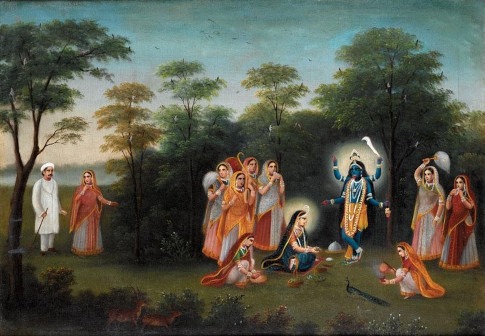
In the early 20th century, the vibrant artistic traditions of Bengal crossed borders and found fertile ground in the cultural capitals of the world: London and Paris. The Bengal School of Art, an indigenous modernist movement that began in Calcutta (now Kolkata), was strongly influenced by the colonial context and the British imperial presence. What began as a response to European academicism and a search for national identity in India’s visual arts, eventually rippled through Europe, enriching global art movements.
The Birth of the Bengal School of Art
The Bengal School of Art was a rejection of European academic realism and an embrace of India’s ancient artistic traditions. This movement, led by visionary artists like Abanindranath Tagore, Jamini Roy, and Nandalal Bose, sought to blend the techniques of traditional Indian art, including miniatures, folk art, and mural painting, with modern aesthetics.
The Bengal School of Art emerged during a time of nationalist fervor as part of the Bengal Renaissance. The artists were intent on breaking free from colonial art forms and using Indian visual language to express the spiritual and cultural essence of India.
Bengal’s Influence in London: An Artistic Dialogue with the West
In the early 1900s, as Indian art started gaining visibility in the global art world, London became a major venue for art exhibitions showcasing the works of Bengali artists. One of the key moments was the 1911 Indian Exhibition at the Royal Academy of Arts in London, which featured works from Bengal. It brought the Bengali aesthetic to the attention of the British art world, which had long been dominated by European styles.
Artists like Abanindranath Tagore and Gaganendranath Tagore became crucial links between Indian traditions and Western modernism. Abanindranath’s influence from Persian and Mughal miniatures, paired with a modern sensibility, found resonance in London’s emerging art nouveau and art deco movements. His work was praised for its delicate handling of watercolors and its mystical, spiritual depth.
Artists like E. B. Havell, an art historian and advocate of Indian arts, played a pivotal role in promoting Bengal’s traditional art forms in Europe. He collaborated with Abanindranath to reclaim and rejuvenate India’s lost heritage, making the Bengal School of Art a symbol of national pride.
Paris: The Fusion of Indian Tradition and European Avant-Garde
While London was the entry point for the Bengal School, Paris provided the perfect platform for these artists to engage with the avant-garde art movements of the time. In the early 20th century, Paris was the heart of modern art, hosting leading figures like Pablo Picasso, Henri Matisse, and Giorgio de Chirico.
When Bengal’s artists began exhibiting in Paris, their unique aesthetic caught the eye of the French avant-garde. Nandalal Bose, one of the most influential figures in the Bengal School, spent significant time in Paris, where he was inspired by the Cubist and Expressionist movements. His use of bold, simplified forms and rich symbolism resonated with European artists who were looking for ways to break free from tradition.
The French embraced the exoticism of Indian art, but the Bengal School artists were not content with mere visual appeal. They were keen to express Indian spirituality, mythology, and national identity through their works. This fusion of traditional Indian art with modern European aesthetics resulted in a dynamic and innovative style.
Key Artists and Their Global Impact
- Abanindranath Tagore: His landmark work, Bharat Mata (Mother India), not only symbolized the national consciousness of India but also stood as an example of a new modern Indian style that incorporated Western influences without losing its Indian roots.
- Nandalal Bose: Renowned for his murals and iconographic illustrations, he influenced many artists in both India and the West, promoting Indian themes in modern artistic styles. His works in Paris were a testament to the global appeal of Indian art fused with modernist sensibilities.
- Jamini Roy: Though later than Abanindranath and Nandalal, Roy’s return to folk and tribal art forms was a declaration of independence from Western academic realism. His bold, flat colors and simplified figures found fans in both Europe and America, including exhibitions in New York.
The Bengal School’s Lasting Legacy
The impact of the Bengal School on Western art cannot be overstated. Through exhibitions in London and Paris, the Bengal School artists succeeded in placing Indian modernism on the global stage. They bridged the gap between traditional Indian art and the global modernist movement, influencing not only the art world but also the nationalist consciousness in India.
Today, the influence of Bengal’s art can be seen in many contemporary artists who continue to draw on its rich heritage. The Bengal School of Art remains a significant chapter in the history of global modernism, illustrating how cultural exchange can lead to a new, hybrid artistic language.